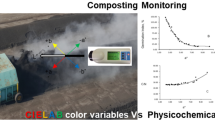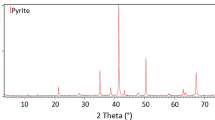Abstract
Color, a readily perceived feature of natural earth materials, including mine waste, often represents compositional variation as a result of oxidative processes involving Fe. Near surface samples from excavated trenches in a mine-waste rock pile were collected to investigate the relationship between color and contents of Fe, Cu, and S. The silt+clay fraction (<0.05 mm) was isolated from recognizable colored material of the bulk sample for determination of pH, total and extractable Fe and Cu, and bulk mineralogy. Rock fragments within the pile exhibited coatings of crystalline gypsum and amorphous Fe. These coatings result from weathering (secondary products) and play important roles in surface reactions of waste rock piles, such as adsorption of anions (SO4 2–) or coprecipitation of Fe with Cu. The correlation between color (Hurst method) and extractable Fe was high. Although color is influenced by site conditions such as original mineral composition, materials handling, weathering conditions etc., the results suggest that color measurements may provide an inexpensive and rapid estimation for secondary iron compounds and associated sorbed elements.
Similar content being viewed by others
Author information
Authors and Affiliations
Additional information
Received: 5 April 1998 · Accepted: 30 June 1998
Rights and permissions
About this article
Cite this article
Shum, M., Lavkulich, L. Use of sample color to estimate oxidized Fe content in mine waste rock. Environmental Geology 37, 281–289 (1999). https://doi.org/10.1007/s002540050385
Issue Date:
DOI: https://doi.org/10.1007/s002540050385




